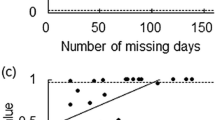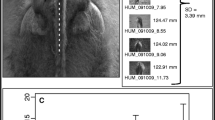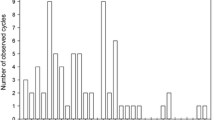Abstract
Although estrous synchrony has been reported in a number of mammalian species, most often among primates, methodological and analytical problems make it difficult to interpret these results. We developed a novel estrous synchrony index and employed a randomization procedure to analyze long-term observations of female chimpanzee (Pan troglodytes schweinfurthii) estrous cycles at the Mahale Mountains National Park, Tanzania. Our results revealed that female chimpanzees at Mahale avoid synchronizing their estrous periods with each other. We also found that birthrates decreased as the breeding sex ratio increased. We suggest that estrous asynchrony decreases female–female competition for mates. Asynchrony may also reduce the potential for male sexual coercion by nonpreferred mating partners.

Similar content being viewed by others
References
Altmann J, Altmann SA, Hausfater G, McCuskey SA (1977) Life history of yellow baboons: physical development, reproductive parameters and infant mortality. Primates 18:315–330
Arark A (1988) Callers and satellites in the natterjack toad: evolutionarily stable decision rules. Anim Behav 36:416–432
Bartholomew GA (1970) A model for the evolution of pinniped polygyny. Evolution 24:546–559
Boesch C, Boesch-Achermann H (2000) The chimpanzees of the Taï Forest. Oxford University Press, New York
Clutton-Brock TH (1989) Mammalian mating systems. Proc R Soc Lond B 236:339–372
Clutton-Brock TH, Parker GA (1995) Sexual selection and the potential reproductive rates of male and females. Nature 351:58–60
Constable JL, Ashley MV, Goodall J, Pusey AE (2001) Noninvasive paternity assignment in Gombe chimpanzees. Mol Ecol 10:1279–1300
Cox CR, Le Boeuf BJ (1977) Female incitation of male competition: a mechanism in sexual selection. Am Nat 111:317–335
Deschner T, Heistermann M, Hodges K, Boesch C (2003) Timing and probability of ovulation in relation to sex skin swelling in wild West African chimpanzees, Pan troglodytes verus. Anim Behav 66:551–560
Dunbar RIM (1980) Demographic and life history variables of a population of Gelada baboons (Theropithecus gelada). Behav Ecol Sociobiol 7:253–265
Dunbar RIM (1984) Reproductive decisions. Princeton University Press, Princeton
Dunbar RIM, Sharman M (1983) Female competition for access to males affects birth rate in baboons. Behav Ecol Sociobiol 13:157–159
Eberle M, Kappeler PM (2002) Mouse lemurs in space and time: a test of the socioecological model. Behav Ecol Sociobiol 51:131–139
Edgington ES (1995) Randomization tests. Marcel Dekker, New York
Emlen ST, Oring LW (1977) Ecology, sexual selection, and the evolution of mating systems. Science 197:215–223
Findlay CS, Cooke F (1982) Breeding synchrony in the lesser snow goose (Anser caerulescens caerulescens). I. Genetic and environmental components of hatch date variability and their effects on hatch synchrony. Evolution 36:342–351
French JA, Stribley JA (1987) Synchronization of ovarian cycles within and between social groups in golden lion tamarins (Leontopithecus rosalia). Am J Primatol 12:469–478
Goodall J (1986) The chimpanzees of Gombe. Harvard University Press, Cambridge
Gowaty PA (2004) Sex roles, contents for the control of reproduction, and sexual selection. In: Kappeler PM, van Schaik CP (eds) Sexual selection in primates. Cambridge University Press, Cambridge, UK, pp 37–54
Graham C (1981) Menstrual cycle physiology of the great apes. In: Graham CE (ed) Reproductive biology of the great apes. Academic Press, New York, pp 286–303
Handelmann G, Ravizza R, Ray WJ (1980) Social dominance determines estrous entrainment among female hamsters. Horm Behav 14:107–115
Hasegawa T, Hiraiwa-Hasegawa M (1983) Opportunistic and restrictive mating among wild chimpanzees in the Mahale Mountains, Tanzania. J Ethol 1:75–85
Howard RD (1980) Mating behaviour and mating success in wood frog Rana sylvatica. Anim Behav 28:705–716
Ims RA (1990) The ecology and evolution of reproductive synchrony. TREE 5:135–140
Kappeler PM, van Schaik CP (2004) Sexual selection in primates: review and selective preview. In: Kappeler PM, van Schaik CP (eds) Sexual selection in primates. Cambridge University Press, Cambridge, UK, pp 3–23
Kappeler PM (2000) Primate males. In: Kappler PM (ed) Primate males. Cambridge University Press, Cambridge, UK, pp 3–7
Kummer H (1968) Social Organization of hamadryas baboons. University of Chicago Press, Chicago
Loy J, Loy K (1977) Sexual harassment among captive patas monkeys Erythrocebus patas. Primates 18:691–699
Matsumoto-Oda A, Kasuya E (2005) Proximity and estrous synchrony in Mahale chimpanzees. Am J Primatol 66:159–166
McClintock MK (1971) Menstrual synchrony and suppression. Nature 229:244–255
McClintock MK (1978) Estrous synchrony and its mediation by airborne chemical communication (Rattus norvegicus). Horm Behav 10:264–276
Monfort SK, Bush M, Wildt DE (1996) Natural and induced ovarian synchrony in golden lion tamarins (Leontopithecus rosalia rosalia). Biol Reprod 55:875–882
Nishida T (1989) Social interactions between resident and immigrant female chimpanzees. In: Heltne PG, Marquardt LA (eds) Understanding chimpanzees. Harvard University Press, Cambridge Mass, pp 68–89
Nishida T, Takasaki H, Takahata Y (1990) Demography and reproductive profiles. In: Nishida T (ed) The chimpanzees of the Mahale Mountains. University of Tokyo Press, Tokyo, pp 63–68
Nishida T, Corp N, Hamai M, Hasegawa T, Hiraiwa-Hasegawa M, Hosaka K, Hunt KD, Itoh N, Kawanaka K, Matsumoto-Oda A, Mitani JC, Nakamura M, Norikoshi K, Sakamaki T, Turner L, Uehara S, Zamma K (2003) Demography, female life history and reproductive profiles among the chimpanzees of Mahale. Am J Primatol 59:99–121
Pereira ME (1991) Asynchrony within estrous synchrony among ringtailed lemurs (Primates: Lemuridae). Physiol Behav 49:47–52
Rosenthal R (1991) Meta-analytic procedures for social research. Sage Publications, London
Sauther ML (1991) Reproductive behavior of free-ranging Lemur catta at Beza Mahafaly special reserve, Madagascar. Am J Phys Anthropol 84:463–477
Schank JC (2000) Menstrual-cycle variability and measurement: further cause for doubt. Psychoneuroendocrinology 25:837–847
Schank JC (2001) Measurement and cycle variability: reexamining the case for ovarian-cycle synchrony in primates. Behavioral Processes 56:131–146
Schank JC (2004) Avoiding synchrony as a strategy of female mate choice. Nonlinear Dyn Psychol Life Sci 8:147–176
Setchell JM, Kappeler PM (2003) Selection in relation to sex in primates. Adv Study Behav 33:87–174
Short RV (1981) Sexual selection in man and the great apes. In: Graham CE (ed) Reproductive biology of the great apes. Academic, New York, pp 319–341
Small MF (1988) Female primate sexual behavior and conception. Are there really sperm to spare? Curr Anthropol 29:81–99
Smuts BB (1987) Sexual competition and mate choice. In: Smuts BB, Cheney DL, Seyfarth RM, Wrangham RW, Struhsaker TT (eds) Primates societies. University of Chicago Press, Chicago, pp 385–399
Smuts BB, Smuts RW (1993) Male aggression and sexual coercion of females in nonhuman primates and other mammals: evidence and theoretical implications. Adv Stud Behav 22:1–63
Strassmann BI (1997) The biology of menstruation in Homo sapiens: total lifetime menses, fecundity, and nonsynchrony in a natural-fertility population. Curr Anthropol 18:123–129
Tutin CEG (1979) Mating patterns and reproductive strategies in a community of wild chimpanzees (Pan troglodytes schweinfurthii). Behav Ecol Sociobiol 6:29–38
Wallis J (1985) Synchrony of estrous swelling in captive group-living chimpanzees (Pan troglodytes). Int J Primatol 6:335–350
Wallis J (1992) Socioenvironmental effects on timing of first postpartum cycles in chimpanzees. In: Nishida T, McGrew WC, Marler P (eds) Topics in primatology, vol 1. University of Tokyo Press, Tokyo, pp 119–130
Wallis J (1997) A survey of reproductive parameters in the free-ranging chimpanzees of Gombe National Park. J Reprod Fertil 109:297–307
Watts DP (1990) Mountain gorilla life histories, reproductive competition, and sociosexual behavior and some implications for captive husbandry. Zoo Biol 9:185–200
Weller L, Weller A (1993) Human menstrual synchrony: a critical assessment. Neurosci Biobehav Rev 17:427–439
Wilson HC (1992) A critical review of menstrual synchrony research. Psychoneuroendocrinology 17:565–591
Zinner DP, Schwibbe MH, Kaumanns W (1994) Cycle synchrony and probability of conception in female hamadryas baboons Papio hamadryas. Behav Ecol Sociobiol 35:175–183
Acknowledgement
T. Nishida, the late S. Uehara, and many others who shared the fieldwork in the Mahale Mountains National Park, Tanzania; their contribution to the data was indispensable. Besides some of them, F. W. Marlowe, R. Oda, A. E. Pusey, and K. Tsuji commented on earlier versions, which greatly improved this paper. The Japan Ministry of Education, Culture, Sports, Science and Technology mainly supported the fieldwork financially. The Tanzania National Parks, Scientific Research Council, Serengeti Wildlife Research Institute, and their subsidiaries facilitated our research. We make grateful acknowledgement to these people and institutions.
Author information
Authors and Affiliations
Corresponding author
Additional information
Communicated by S. Alberts
Rights and permissions
About this article
Cite this article
Matsumoto-Oda, A., Hamai, M., Hayaki, H. et al. Estrus cycle asynchrony in wild female chimpanzees, Pan troglodytes schweinfurthii . Behav Ecol Sociobiol 61, 661–668 (2007). https://doi.org/10.1007/s00265-006-0287-9
Received:
Revised:
Accepted:
Published:
Issue Date:
DOI: https://doi.org/10.1007/s00265-006-0287-9




